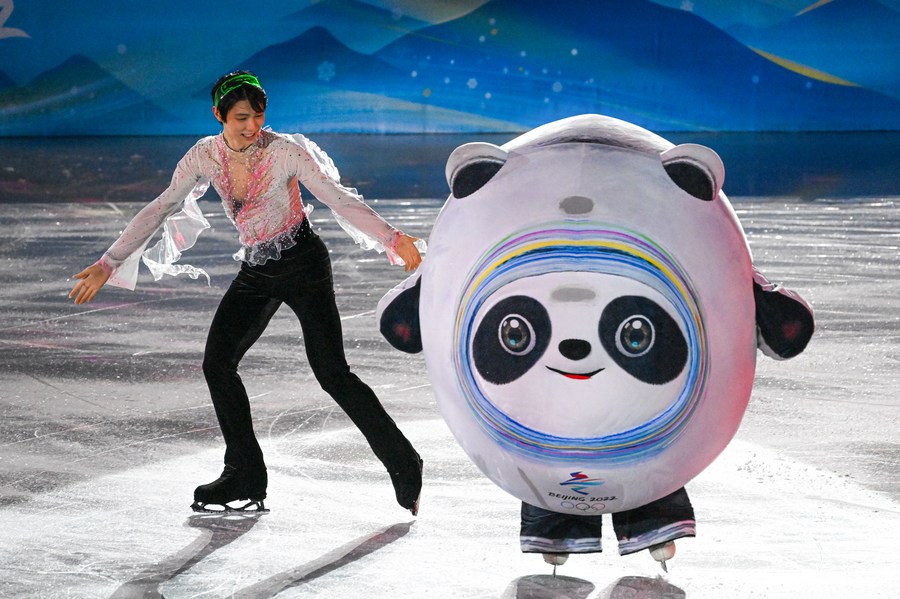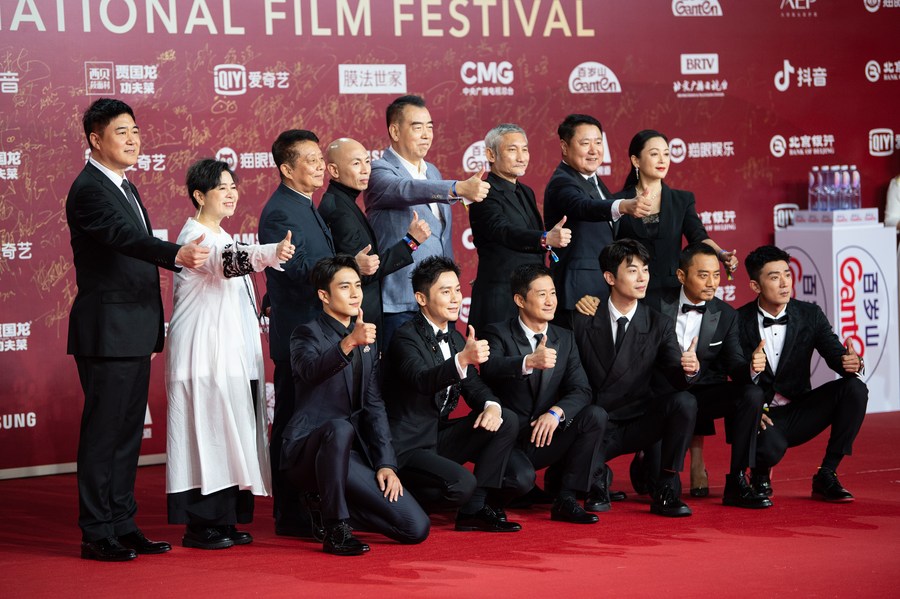Decade of Miracles: A snapshot of China's cultural advancement

Hanyu Yuzuru of Japan and Bing Dwen Dwen perform during the figure skating gala event of the Beijing 2022 Winter Olympics at Capital Indoor Stadium in Beijing, capital of China, Feb. 20, 2022. (Xinhua/Wang Fei)
BEIJING, March 10 (Xinhua) -- What are the first names that pop up in your mind regarding which cultural phenomena or moments have impressed you most in recent years?
Bing Dwen Dwen, the Beijing 2022 Winter Olympic Mascot; The Battle at Lake Changjin, the all-time top-earning Chinese film series; The Three-Body Problem, the award-winning sci-fi novel trilogy by Liu Cixin; or anything else?
The answer varies for different people. It's especially true if you examine the changes taking place in China over the past 10 years through a popular cultural lens.
Indeed, even the pickiest of the China cultural observers would agree that with the country's victory in eradicating absolute poverty and achieving moderate prosperity also came noticeable strides in cultural advancement over the past decade.
OLYMPIC MASCOT
Bing Dwen Dwen, a chubby giant panda cub in a hard transparent bodysuit, is a superstar from the Beijing 2022 Winter Olympics.
On the Games' opening day, over one million people flooded the official Olympics online store on Alibaba's e-commerce platform Tmall to buy Bing Dwen Dwen mascots and other merchandise, according to a report by Alibaba.
The panda mascot is an example of a design with uniquely Chinese characteristics that "integrates Chinese history and culture into the DNA of the design" and "transcends national boundaries and languages," according to its creator Cao Xue, who is with the Guangzhou Academy of Fine Arts.
Two weeks after the Games closing, Bing Dwen Dwen continues to be a smash hit.
Fan Di'an, president of the China Artists Association, attributes the fact that Bing Dwen Dwen and Shuey Rhon Rhon, the fluffy red lantern-shaped Paralympic mascot, have become cultural icons to the people's increased confidence in Chinese culture.

Cast members of the film the Battle at Lake Changjin pose for a group photo on the red carpet for the 11th Beijing International Film Festival in Beijing, capital of China, Sept. 20, 2021. (Xinhua/Chen Zhonghao)
FILMMAKING
In building a moderately prosperous society in all respects, China has promoted the creative evolution of fine traditional culture. At the same time, public cultural services have been improved, with cultural programs and industries flourishing.
China's filmmaking, sci-fi, and internet development, to name a few, are among the highlights.
Before the COVID-19 pandemic broke out in 2020, China's yearly box office total grew straight from 17 billion yuan (about 2.69 billion U.S. dollars) in 2012 to 64 billion yuan in 2019.
Since the pandemic, China continued to lead the world in terms of the recovery speed of its movie industry and has claimed the worldwide box office crown for two consecutive years, with 20 billion yuan in 2020 and 47 billion yuan in 2021.
China's box office landscape is also much different than the early 2010s and earlier when many of the top yearly earners were Hollywood titles.
With a steady improvement in quality, domestic titles now account for an overwhelming majority of China's yearly box office revenue. "By and large, as the quality of domestic films improves, audiences are turning away from Hollywood movies," said Yin Hong, vice chairman of the China Film Association and a professor at Tsinghua University.
The 2021 patriotic Chinese film "The Battle at Lake Changjin," set during the War to Resist U.S. Aggression and Aid Korea (1950-1953), grossed a whopping 5.77 billion yuan, becoming the top earner of all time at China's box office.
Yin expected Chinese animated films to achieve a breakthrough in communicating Chinese culture to the rest of the world, noting "a unique art style of Chinese animation in the making, which breaks away from the old style of Hollywood or Japanese animation."

A woman visits an exhibition in Shanghai, east China, Feb. 24, 2021. An exhibition of Three-Body, an award-winning sci-fi trilogy by Liu Cixin, is held at Shanghai Tower. (Xinhua/Zhang Jiansong)
SCI-FI
In January this year, the final episode of the Chinese audio drama "Three-Body" was released on the online audio platform Ximalaya to wide applause from internet users.
It marked the completion of the 100-episode radio drama based on Liu Cixin's award-winning sci-fi novel "The Three-Body Problem," with the hashtag "How do you like 'Three-Body' radio drama" generating millions of reads on microblogging platform Weibo.
"The Three-Body Problem" is the first book in a sci-fi trilogy that revolves around physicist Ye Wenjie's contact with the Trisolaran civilization living in a three-sun system. It follows the centuries-long clashes between earthlings and aliens.
It is not the first time "The Three-Body Problem" has made news headlines. It came just two months after the first trailer of the highly-anticipated Chinese TV adaptation of the novel was released by Chinese online streaming platform Tencent Video in November 2021.
Serving as an example of the appeal of Chinese art and literary creations, the popularity enjoyed by "The Three-Body Problem" also echoes China's firm steps to promote cultural services last decade.
The number of museums in China rose from 2,838 in 2012 to 3,671 in 2021 and that of public libraries from 2,975 to 3,217, according to official figures. The yearly number of books printed in China rose from 8.1 billion to 11 billion.
The availability of IT applications important for cultural services to be delivered has also improved, as China's netizen number soared from 564 million in 2012 to 1.03 billion in 2021.
Photos
Related Stories
- Sit skier fulfills dream to represent Denmark at the Beijing 2022 Winter Paralympics
- Norway's Pedersen wins third gold at Beijing Winter Paralympics
- Profile: Italian Para ice hockey player enjoying life despite difficulties
- Feature: Beijing 2022 brings new level to global Para sports
- Feature: Cross-country skier makes history in China's Winter Paralympic squad
Copyright © 2022 People's Daily Online. All Rights Reserved.










